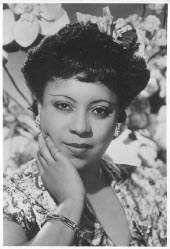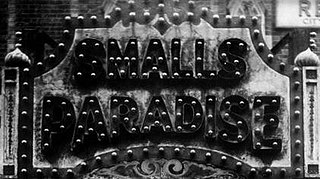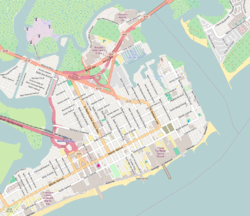
The Apollo Theater is a multi-use theater at 253 West 125th Street in the Harlem neighborhood of Upper Manhattan in New York City. It is a popular venue for black American performers and is the home of the TV show Showtime at the Apollo. The theater, which has approximately 1,500 seats across three levels, was designed by George Keister with elements of the neoclassical style. The facade and interior of the theater are New York City designated landmarks and are listed on the National Register of Historic Places. The nonprofit Apollo Theater Foundation (ATF) operates the theater, as well as two smaller auditoriums at the Victoria Theater and a recording studio at the Apollo.

The Cotton Club was a New York City nightclub from 1923 to 1940. It was located on 142nd Street and Lenox Avenue (1923–1936), then briefly in the midtown Theater District (1936–1940). The club operated during the United States' era of Prohibition and Jim Crow era racial segregation. Black people initially could not patronize the Cotton Club, but the venue featured many of the most popular black entertainers of the era, including musicians Fletcher Henderson, Duke Ellington, Jimmie Lunceford, Chick Webb, Louis Armstrong, Count Basie, Fats Waller, Willie Bryant; vocalists Adelaide Hall, Ethel Waters, Cab Calloway, Bessie Smith, Lillie Delk Christian, Aida Ward, Avon Long, the Dandridge Sisters, the Will Vodery choir, The Mills Brothers, Nina Mae McKinney, Billie Holiday, Midge Williams, Lena Horne, and dancers such as Katherine Dunham, Bill Robinson, The Nicholas Brothers, Charles 'Honi' Coles, Leonard Reed, Stepin Fetchit, the Berry Brothers, The Four Step Brothers, Jeni Le Gon and Earl Snakehips Tucker.

Elvera "Baby" Sanchez Davis was an American dancer and the mother of Sammy Davis Jr.
The Chitlin' Circuit was a collection of performance venues found throughout the eastern, southern, and upper Midwest areas of the United States. They provided commercial and cultural acceptance for African-American musicians, comedians, and other entertainers following the era of venues run by the "white-owned-and-operated Theatre Owners Booking Association (TOBA)...formed in 1921." The Chitlin Circuit sustained black musicians and dancers during the era of racial segregation in the United States from the 1930s through the '60s.

Adelaide Louise Hall was an American-born UK-based jazz singer and entertainer. Her career spanned more than 70 years from 1921 until her death. Early in her career, she was a major figure in the Harlem Renaissance; she became based in the UK after 1938. Hall entered the Guinness Book of World Records in 2003 as the world's most enduring recording artist, having released material over eight consecutive decades. She performed with major artists such as Art Tatum, Ethel Waters, Josephine Baker, Louis Armstrong, Lena Horne, Bill "Bojangles" Robinson, Cab Calloway, Fela Sowande, Rudy Vallee, and Jools Holland, and recorded as a jazz singer with Duke Ellington and with Fats Waller.

Clicquot Club was a nightclub at 15 North Illinois Avenue in Atlantic City, New Jersey, in the heart of the city. Billed as the club that "never closed", it became notorious as an illegal gambling spot in the city.
Joseph Christopher Columbus Morris, better known as Crazy Chris Columbo or just Chris Columbo, was an American jazz drummer. He was sometimes credited as Joe Morris on record, though he is no relation to free jazz guitarist Joe Morris or trumpeter Joe Morris.

Leonard Harper was a producer, stager, and choreographer in New York City during the Harlem Renaissance in the 1920s and 1930s.

Smalls Paradise, was a nightclub in the Harlem neighborhood of Manhattan in New York City. Located in the basement of 2294 Adam Clayton Powell Jr. Boulevard at 134th Street, it opened in 1925 and was owned by Ed Smalls (né Edwin Alexander Smalls; 1882–1976). At the time of the Harlem Renaissance, Smalls Paradise was the only one of the well-known Harlem night clubs to be owned by an African-American and integrated. Other major Harlem night clubs admitted only white patrons unless the person was an African-American celebrity.

The 500 Club, popularly known as The Five, was a nightclub and supper club at 6 South Missouri Avenue in Atlantic City, New Jersey, United States. It was owned by racketeer Paul "Skinny" D'Amato, and operated from the 1930s until the building burned down in 1973.
The Paradise Club or Club Paradise was a nightclub and jazz club at 220 North Illinois Avenue in Atlantic City, New Jersey. It was one of two major black jazz clubs in Atlantic City during its heyday from the 1920s through 1950s, the other being Club Harlem. Entertaining a predominantly white clientele, it was known for its raucous floor shows featuring gyrating black dancers accompanied by high-energy jazz bands led by the likes of Count Basie, Jimmie Lunceford, and Lucky Millinder. In 1954 the Paradise Club merged with Club Harlem under joint ownership.

Babette's or Babette's Supper Club was a supper club and bar at 2211 Pacific Avenue on the Boardwalk of Atlantic City, New Jersey, United States. It operated from the early 1920s onwards and was sold in 1950. The bar was designed like a ship's hull. In the backroom was a gambling den, which was investigated by the federal authorities and raided in 1943.
Kentucky Avenue Renaissance Festival, also known as the Historical Kentucky Avenue Renaissance Festival, is a street fair held each summer in the former black entertainment district of Atlantic City, New Jersey. Founded in 1992, it appeared annually until 2001, and then resumed in 2011. Held on and around the site of the razed Club Harlem, the weekend fair commemorates the R&B and jazz nightspots that once lined Kentucky Avenue and that attracted both black and white clientele in its heyday from the 1940s through 1960s. The festival features live performances by R&B and jazz musicians and bands, dance performances, street performers, arts and crafts for children, and food concessions, and draws hundreds of attendees.

Grace's Little Belmont was a jazz music bar and lounge in Atlantic City, New Jersey. Located at 37 North Kentucky Avenue, it was one of the four popular black nightclubs situated on that street between the mid-1930s and mid-1970s; the others were Club Harlem, the Paradise Club, and the Wonder Gardens. The Little Belmont was located across the street from Club Harlem, with which it often shared performers and patrons. Wild Bill Davis and his swing and jazz quartet were featured summer performers from 1950 through the mid-1960s, and Elvera M. "Baby" Sanchez, mother of Sammy Davis, Jr., worked at the bar. The club closed in the mid-1970s and was later demolished.

Wonder Gardens was a jazz and R&B nightclub at 1601 Arctic Avenue in Atlantic City, New Jersey. Established around 1929, it was one of four black-owned nightclubs in the black entertainment district on Kentucky Avenue. Between the Wonder Gardens, Club Harlem, the Paradise Club, and Grace's Little Belmont, the music played all night and into the morning in the district's heyday in the 1940s through 1960s. Presenting both popular jazz musicians and new talent, the Wonder Gardens provided early exposure for Dan Fogel, Harvey Mason, George Benson, and the Commodores. Over the years, the music changed from jazz to rock, soul, and pop music. In 1979 the club was renovated, redecorated and renamed the Latin Wonder Gardens, featuring live Afro-Cuban musical entertainment. In 1991 it underwent a second renovation and name change to the New Wonder Gardens, featuring Latin, jazz, R&B, hiphop, and reggae acts. The club was sold in 2001 and was later demolished.

Wash's Restaurant, later called Wash & Sons' Seafood Restaurant, Wash's Inn, and Wash's Catering, was an African-American family-owned and operated soul food restaurant that was in business for over 70 years, first in Atlantic City and then in Pleasantville, New Jersey. Established by Clifton and Alma Washington at 35 N. Kentucky Avenue, Atlantic City, in 1937, the original 20-seat location attained celebrity status for hosting the performers and patrons of the nightclubs in the Kentucky Avenue black entertainment district. The restaurant was known for its sausage sandwiches and soul food, and also served breakfast to customers leaving the 6 a.m. show at Club Harlem.
Larry Steele was an American songwriter, composer, and impresario, notable for his all-black variety revue shows. Steele was dubbed the "Black Flo Ziegfeld" for his dazzling productions. He toured with his troupe called Smart Affairs between from 1947 to 1970. Performers featured in Smart Affairs included Cab Calloway, Nat King Cole, Sammy Davis Jr., Sara Vaughan, and Lou Rawls. As a songwriter, Steele wrote over 200 songs over the course of his career.
Olga James is an American singer and actress best known for her role in the film Carmen Jones (1954). Her later acting credits include a role in the Broadway musical Mr. Wonderful and a recurring role on The Bill Cosby Show.
The Chocolate Kiddies is a three-act Broadway-styled revue that, in its inaugural production – from May to September 1925 – toured Berlin, Hamburg, Stockholm, and Copenhagen. The show never actually performed on Broadway, but was conceived, assembled, and rehearsed there. Chocolate Kiddies commissioned new works, but was also an amalgamation and adaptation of several leading African American acts in New York, specifically Harlem, intended to showcase exemplary jazz and African American artistry of the Harlem Renaissance. Early jazz was uniquely American; and, while New Orleans enjoys popularity for being its birthplace, the jazz emerging from Harlem during the Renaissance had, on its own merits, captured international intrigue.

The Northside was a historically African American neighborhood confined within an area of around one mile in the west side of Atlantic City. It was a neighborhood subject to the racial discrimination tactic of redlining, where investors did not invest in an area due to its demographics and prevented buildup of generational wealth. This led to many businesses and housing complexes being built by the government and wealthy black investors in the area, such as Leroy "Pop" Williams.















